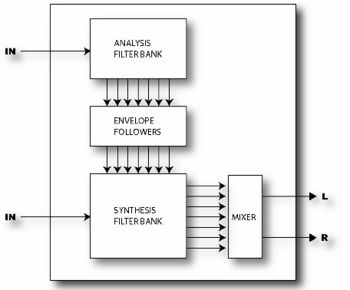Vocoder
The Axe-Fx UltraTM has a digital recreation of the classic analog Vocoder. The Vocoder, created by Homer Dudley, was originally designed as means of compressing human speech for transmission over narrow-band carrier channels. Impressive amounts of compression can be achieved while still rendering speech intelligible. Although it never really gained acceptance for that application, it later found usefullness as a means of encrypting speech for wartime communications. In the 1970’s Robert Moog and Wendy Carlos pioneered the use of the Vocoder for musical applications.
The Axe-Fx Vocoder pays faithful homage to those early analog vocoders. Using a true constant-Q approach the Axe-Fx Vocoder can be used to make your guitar “talk” or make your voice sound like a robot or other strange and interesting effects.
When using the Vocoder with your guitar or other instrument as the carrier (synthesis bank), resist the urge to sing along. Speaking in a monotone voice yields the best results.
Parameters
- INSEL - Selects the input to use for the synthesis (carrier) channel. This is the input to use for your guitar or other instrument. The other input is then the analysis channel and is typically used for vocal input.
- BANDS - Selects the number of bands to use in the analysis and synthesis filter banks.
- FMIN - Sets the frequency of the lowest filter band.
- FMAX - Sets the frequency of the highest filter band.
- RES - Sets the Q, or bandwidth of the filters. Higher values yield narrower filters.
- SHIFT - Shifts the frequency of the synthesis bands relative to the analysis bands. This allows you to change the character of the vocoding and produce “anonymous mob informant” or “chipmunk” effects.
- HPMIX - Sets the amount of highpass filtered signal to mix in with the synthesis output. This can be used to increase the intelligibility of the vocoding.
- ATT - Sets attack filter time for the envelope followers.
- REL - Sets release filter time for the envelope followers.
- FREEZE - Turning this to ON, freezes the output of the envelope followers. This can be used to hold the vocal formant.
- MLVL - Sets the master level for all the synthesis filter outputs.
- MPAN - Sets master panning for all the synthesis filter outputs.
Individual control of the filter output levels and panning is provided on dedicated menu pages. You can use these controls to fine tune the filter bank response and control the panning of the filter outputs.
